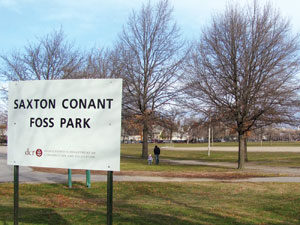 Eagle Feathers #291 – Foss Park
Eagle Feathers #291 – Foss Park
By Bob (Monty) Doherty
Construction of what is known as today’s Foss Park began in 1872, the year Somerville became a city. For two years prior, there was intense bitterness and controversy regarding its location, layout and design.
Residents throughout the then town wanted Broadway Park, its original name, to be more centrally located. One score or 20 years later, an 1892 newspaper article suggested that it was used more by Charlestown citizens than Somerville residents.
United States Army Private Saxton Conant Foss, enlisted for service in June, 1917. He was the son of renowned poet Samuel Walter Foss who was considered by many to be the most beloved man in Somerville.

While fighting as part of the 9th Infantry Regiment, 2nd Division, Saxton volunteered to flank a German machine gun nest which was holding his battalion from moving forward. While doing so, he was fatally wounded four days before his thirtieth birthday. For this act, he was cited by Congress for extraordinary heroism in action and posthumously awarded the Distinguished Service Cross and the Silver Star.
In 1926, Broadway Park was renamed Foss Park in honor of Saxton Conant Foss who sacrificed his life for America and its allies during World War I. Somerville honors him with memorials in both Foss Park and Trum Field.

Foss was born in Somerville on October 13, 1888. He attended the Morse Grammar School and the Somerville Latin School and graduated in 1906. He then went on to Harvard College and graduated in 1910. Before entering the service, he worked for the Somerville Journal, the Christian Science Monitor and the Boston Globe. While overseas, he wrote letters home presenting a soldier’s point of view.
Originally Foss Park was graced with gardens, walkways and fountains. Today, it offers baseball, softball and soccer fields and includes tennis courts, a children’s park and a swimming pool.

Through the years, the site of Saxton’s Park has witnessed much history.
- The path of Paul Revere’s ride skirted its edge; and to this day, annual reenactments are reminders of this historic event.
- The twenty-six-mile Middlesex Canal ran from Lowell to Boston and delivered historic Concord River water through the park for over a half century.

Today, Canal Lane and Middlesex Avenue honor the canal, and four monuments salt its path throughout the city. They are located
- in front of the East Somerville library
- in front of the former St. Polycarp’s Church
- at the intersection of Boston Avenue and Alewife Brook Parkway
- at Foss Park with two stone markers which reveal a partial location of the historic canal.
Saxton loved his famous father. Samuel was a learned poet and head of the Somerville library for thirteen years which he ultimately transformed into the second largest library in New England.
During the war, a friend of Saxton asked him why he enlisted. He made no reply, but emotionally pointed to a picture of his father. This is where the heroic soldier drew his inspiration.















Reader Comments